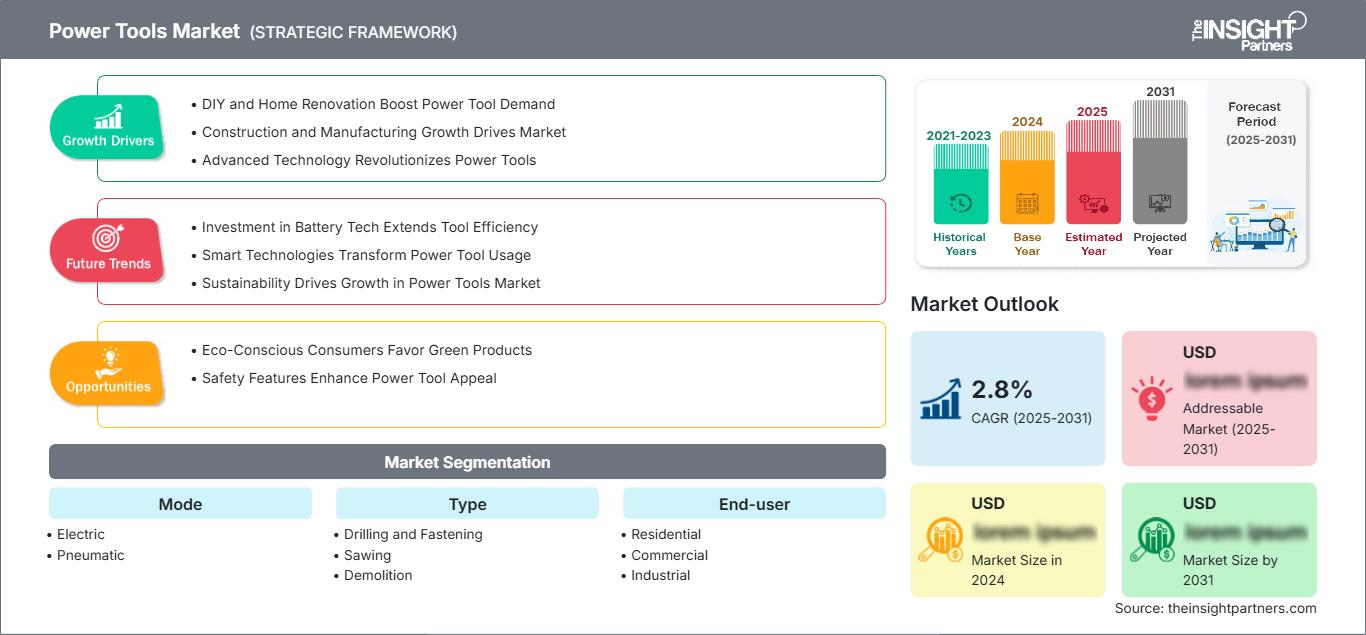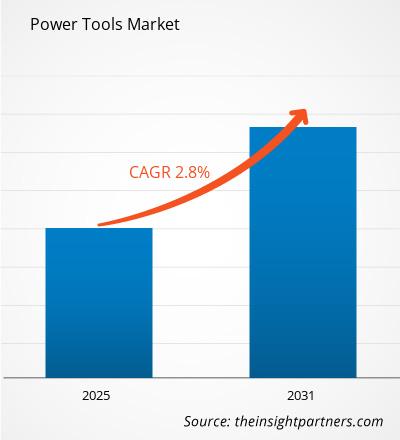Se espera que el mercado de herramientas eléctricas registre una CAGR del 2,8% entre 2025 y 2031, con un tamaño de mercado que se expandirá de US$ XX millones en 2024 a US$ XX millones en 2031.
El informe de mercado de herramientas eléctricas abarca el análisis por modo (eléctrico, neumático, otros); tipo (perforación y fijación, aserrado, demolición, remoción de material); usuario final (residencial, comercial, industrial) y geografía (América del Norte, Europa, Asia Pacífico, América del Sur y Central).
Propósito del Informe
El informe "Mercado de Herramientas Eléctricas" de The Insight Partners busca describir el panorama actual y el crecimiento futuro, los principales factores impulsores, los desafíos y las oportunidades. Esto proporcionará información a diversas partes interesadas del negocio, como:
- Proveedores/fabricantes de tecnología: Para comprender la dinámica cambiante del mercado y conocer las oportunidades potenciales de crecimiento, lo que les permitirá tomar decisiones estratégicas informadas.
- Inversores: Realizar un análisis exhaustivo de tendencias respecto a la tasa de crecimiento del mercado, las proyecciones financieras del mercado y las oportunidades que existen en toda la cadena de valor.
- Órganos reguladores: Regular las políticas y las actividades policiales en el mercado con el objetivo de minimizar el abuso, preservar la confianza de los inversores y defender la integridad y estabilidad del mercado.
Segmentación del mercado de herramientas eléctricas
Modo
- Eléctrico
- Neumático
Tipo
- Perforación y fijación
- Aserradura
- Demolición
- Eliminación de material
Usuario final
- Residencial
- Comercial
- Industrial
Geografía
- América del norte
- Europa
- Asia-Pacífico
- América del Sur y Central
- Oriente Medio y África
Obtendrá personalización en cualquier informe, sin cargo, incluidas partes de este informe o análisis a nivel de país, paquete de datos de Excel, así como también grandes ofertas y descuentos para empresas emergentes y universidades.
Mercado de herramientas eléctricas: perspectivas estratégicas

- Obtenga las principales tendencias clave del mercado de este informe.Esta muestra GRATUITA incluirá análisis de datos, desde tendencias del mercado hasta estimaciones y pronósticos.
Factores que impulsan el crecimiento del mercado de herramientas eléctricas
- El bricolaje y las reformas del hogar impulsan la demanda de herramientas eléctricas: Algunos de los principales factores que impulsan el mercado global de herramientas eléctricas son el aumento de las actividades de bricolaje y las reformas del hogar. Dado que cada vez más personas desean realizar mejoras en sus hogares, la demanda de herramientas eléctricas flexibles y fáciles de usar está en aumento. Alrededor del 45 % de los consumidores realiza alguna actividad de bricolaje, lo que aumenta considerablemente la cuota de mercado de las herramientas eléctricas. Los informes de mercado recientes muestran que esta tendencia inspira innovación. Por ello, los fabricantes presentan diversos productos que responden a las necesidades de los consumidores.
- El crecimiento de la construcción y la manufactura impulsa el mercado: El mayor crecimiento de los sectores relacionados con la construcción y la manufactura a nivel mundial contribuye al crecimiento del mercado de herramientas eléctricas. Con el auge de los proyectos de infraestructura, existe una necesidad de herramientas eléctricas eficientes y duraderas. Esta tendencia al alza está cambiando las tendencias del mercado, ya que las empresas buscan invertir en soluciones innovadoras que mejoren su productividad y satisfagan las rigurosas demandas de sus aplicaciones industriales.
- La tecnología avanzada revoluciona las herramientas eléctricas: La tecnología de vanguardia en herramientas eléctricas ha revolucionado el mercado, impulsando así su crecimiento. Con diseños inalámbricos, funciones inteligentes y tecnologías de batería más potentes, las herramientas se han transformado en modelos mucho más eficaces y fáciles de usar.
Tendencias futuras del mercado de herramientas eléctricas
- La inversión en tecnología de baterías aumenta la eficiencia de las herramientas: Los líderes han estado invirtiendo en las últimas tecnologías de baterías con el objetivo de prolongar la autonomía y reducir el tiempo de carga. Más del 65 % de los contratistas han indicado en encuestas recientes que la flexibilidad en el lugar de trabajo define el uso preferido de las herramientas inalámbricas. Un análisis FODA revela oportunidades de innovación basadas en una mayor competencia entre los vendedores para satisfacer las crecientes preferencias de los consumidores.
- Las tecnologías inteligentes transforman el uso de las herramientas eléctricas: Las tecnologías inteligentes se integran cada vez más en las herramientas eléctricas. Las empresas desarrollan herramientas con capacidad IoT que permite la verificación remota del rendimiento y las necesidades de mantenimiento. Según datos de 2023, el 40 % de los consumidores está interesado en funciones inteligentes que puedan mejorar la eficiencia. Un análisis PEST indicará cómo esta tecnología fomenta el interés del consumidor e impulsa nuevas estrategias de mercado entre los actores clave que se centran en la innovación de herramientas inteligentes.
- La sostenibilidad impulsa el crecimiento del mercado de herramientas eléctricas: La sostenibilidad es una característica del mercado que asume una prioridad crucial en el sector, donde los fabricantes priorizan los materiales ecológicos y las tecnologías energéticamente eficientes. La mitad de los fabricantes de herramientas eléctricas, o aproximadamente el 50%, se están volviendo ecológicos, garantizando que sus productos cumplan con la normativa y las expectativas de los consumidores. Esta tendencia se enmarca en una mayor presión social para el uso de productos y prácticas más limpias.
Oportunidades del mercado de herramientas eléctricas
- Los consumidores con conciencia ecológica prefieren los productos ecológicos: La sostenibilidad es la nueva palabra de moda en el mercado de las herramientas eléctricas y, a partir de ahora, representará una enorme oportunidad de crecimiento para los fabricantes. Más del 40 % de los consumidores de Norteamérica considera importante que los productos sean respetuosos con el medio ambiente. Las empresas que aplican prácticas sostenibles tienen una ventaja competitiva. Un análisis competitivo muestra que las empresas que utilizan materiales reciclados y energéticamente eficientes han conquistado a cada vez más clientes con conciencia ecológica. Esta tendencia está transformando el panorama de la industria, permitiendo a las empresas diferenciarse y satisfacer la creciente demanda de soluciones sostenibles en diferentes geografías.
- Las características de seguridad mejoran el atractivo de las herramientas eléctricas: Las herramientas eléctricas con características de seguridad de alta gama son un factor diferenciador clave en la oportunidad de crecimiento. Una mayor concienciación entre los profesionales para mejorar su seguridad en el trabajo brindará una oportunidad considerable a los fabricantes que implementen mecanismos como el apagado automático y las funciones antirretroceso.
Perspectivas regionales del mercado de herramientas eléctricas
Los analistas de The Insight Partners han explicado detalladamente las tendencias regionales y los factores que influyen en el mercado de herramientas eléctricas durante el período de pronóstico. Esta sección también analiza los segmentos y la geografía del mercado de herramientas eléctricas en América del Norte, Europa, Asia Pacífico, Oriente Medio y África, y América del Sur y Central.
Alcance del informe de mercado de herramientas eléctricas
| Atributo del informe | Detalles |
|---|---|
| Tamaño del mercado en 2024 | US$ XX millones |
| Tamaño del mercado en 2031 | US$ XX millones |
| CAGR global (2025-2031) | 2,8% |
| Datos históricos | 2021-2023 |
| Período de pronóstico | 2025-2031 |
| Segmentos cubiertos | Por modo
|
| Regiones y países cubiertos | América del norte
|
| Líderes del mercado y perfiles de empresas clave |
|
Densidad de actores del mercado de herramientas eléctricas: comprensión de su impacto en la dinámica empresarial
El mercado de herramientas eléctricas está creciendo rápidamente, impulsado por la creciente demanda de los usuarios finales debido a factores como la evolución de las preferencias de los consumidores, los avances tecnológicos y un mayor conocimiento de los beneficios del producto. A medida que aumenta la demanda, las empresas amplían su oferta, innovan para satisfacer las necesidades de los consumidores y aprovechan las tendencias emergentes, lo que impulsa aún más el crecimiento del mercado.

- Obtenga una descripción general de los principales actores clave del mercado de herramientas eléctricas
Puntos clave de venta
- Cobertura integral: el informe cubre exhaustivamente el análisis de productos, servicios, tipos y usuarios finales del mercado de herramientas eléctricas, proporcionando un panorama holístico.
- Análisis de expertos: el informe se compila con base en el conocimiento profundo de expertos y analistas de la industria.
- Información actualizada: El informe asegura relevancia comercial debido a su cobertura de información reciente y tendencias de datos.
- Opciones de personalización: este informe se puede personalizar para satisfacer los requisitos específicos del cliente y adaptarse adecuadamente a las estrategias comerciales.
Por lo tanto, el informe de investigación sobre el mercado de herramientas eléctricas puede ayudar a descifrar y comprender el panorama de la industria y sus perspectivas de crecimiento. Si bien existen algunas preocupaciones válidas, las ventajas generales de este informe suelen superar las desventajas.
- Análisis histórico (2 años), año base, pronóstico (7 años) con CAGR
- Análisis PEST y FODA
- Tamaño del mercado, valor/volumen: global, regional y nacional
- Industria y panorama competitivo
- Conjunto de datos de Excel
Informes recientes
Informes relacionados
Testimonios
Razón para comprar
- Toma de decisiones informada
- Comprensión de la dinámica del mercado
- Análisis competitivo
- Información sobre clientes
- Pronósticos del mercado
- Mitigación de riesgos
- Planificación estratégica
- Justificación de la inversión
- Identificación de mercados emergentes
- Mejora de las estrategias de marketing
- Impulso de la eficiencia operativa
- Alineación con las tendencias regulatorias




















 Obtenga una muestra gratuita para - Mercado de herramientas eléctricas
Obtenga una muestra gratuita para - Mercado de herramientas eléctricas